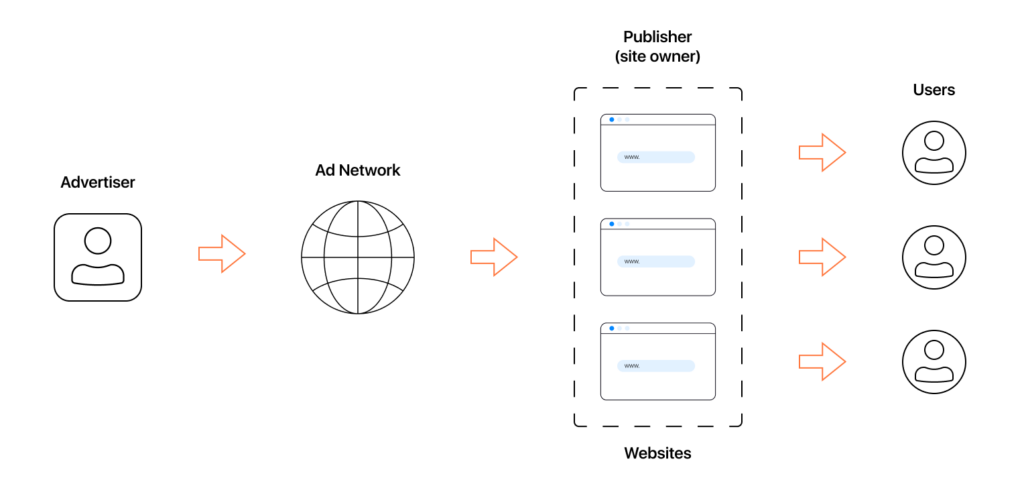Blog

In the advertising ecosystem, there are 2 major platforms that help advertisers achieve their goals: Demand Side Platforms (DSPs) and ad networks. Each automates the buying and selling of ad space, using technology to place ads in optimal traffic sources in real-time. Understanding the specific functionalities and strategic advantages of DSPs and ad networks can significantly enhance your ad performance
This article explores the concepts of ad networks and DSP, highlights their differences, and provides insights into which might be more appropriate for various advertising needs.
A DSP is a system that allows advertisers to buy ad inventory from multiple sources simultaneously, including publishers, ad networks, and ad exchanges. DSPs are designed for those who “demand” ad inventory. They facilitate buying this inventory through automated systems, leveraging real-time bidding (RTB) technology to ensure advertisers can buy the best available ad spaces at optimal prices based on their targeted criteria.
Here’s a detailed look at how DSPs operate:

DSPs offer a powerful toolset for media buying, providing extensive access to diverse ad sources and formats, from classic displays to native and video ads. They enable precise, specialized targeting including retargeting and behavioral analysis, allowing ads to be highly tailored based on user demographics and preferences. Moreover, DSPs deliver transparent, detailed analytics on ad placements and performance across various sites, maximizing ad campaign effectiveness and ROI.
An ad network, or advertising network, is a technology platform that serves as an intermediary between a group of publishers and a pool of advertisers. It consolidates available ad spaces from various publishers and makes these spaces available to advertisers, enabling them to effectively manage and execute their advertising campaigns across multiple websites. Ad Networks streamline the ad buying process by aggregating large amounts of digital ad inventory, which advertisers can utilize to achieve scale and reach in their campaigns.
Check out how ad networks work in detail:

Campaign setup:
Auction process:
Ad delivery and reporting:
It’s partially correct to suggest that ad networks blend the features of DSPs (Demand-Side Platforms) and SSPs (Supply-Side Platforms) since they help connect advertisers with publishers. However, it’s not accurate to claim that ad networks are better or completely replace DSPs and SSPs. Each tool is designed for specific purposes within the advertising ecosystem.
Here are the main differences and functions of each platform:
Ad network:
DSP (Demand-Side Platform):
The distinctions between an ad network and a DSP are outlined in the comparative table below.
| Feature | Ad network | DSP |
|---|---|---|
| Users | Media buyers and advertisers | Publishers and advertisers |
| Primary Function | Aggregation of ad space from various sources | Automated ad buying using real-time bidding |
| Ease of use | Generally simpler and more straightforward | More complex, requires technical knowledge |
| Optimization | Manual and automated | Usually automated |
| Transparency | Less than 100%. Users won’t know which sources their ads will appear in unless they set up whitelists. | Completely transparent. |
Many ad networks focus on particular verticals, offering tailored advertising solutions that are optimized for specific industries. For example, gambling ad networks are tailored for the casino industry and usually have higher entry barriers due to strict regulations and high-value transactions. If you are on the lookout for profitable offers, swing by gambling CPA networks.
Sweepstakes ad networks are ideal for beginners. They offer lower entry thresholds and are an excellent starting point for those new to affiliate marketing. They typically involve promotions where users can win prizes, making them attractive for broad audience engagement.
Examples of renowned ad networks:
Seek for more ad networks and their reviews on our website!
Just as ad networks, DSPs also specialize in the various niches: Adult, Nutra, Finance, mVas and etc.
Examples of renowned ad networks:
When deciding whether to use a DSP or an ad network, consider the following factors:
As you decide which platform best suits your needs, consider the specific nuances of your campaigns and the level of control you desire over ad placements and audience targeting. This decision will not only impact your current campaign performance but also set the stage for future scalability. By making an informed choice between an ad network and a DSP, you ensure that your advertising efforts are both effective and aligned with your overall marketing objectives.
In the advertising ecosystem, there are 2 major platforms that help advertisers achieve their goals: Demand Side Platforms (DSPs) and ad networks. Each automates the buying and selling of ad space, using technology to place ads in optimal traffic sources in real-time. Understanding the specific functionalities and strategic advantages of DSPs and ad networks can significantly enhance your ad performance
This article explores the concepts of ad networks and DSP, highlights their differences, and provides insights into which might be more appropriate for various advertising needs.
A DSP is a system that allows advertisers to buy ad inventory from multiple sources simultaneously, including publishers, ad networks, and ad exchanges. DSPs are designed for those who “demand” ad inventory. They facilitate buying this inventory through automated systems, leveraging real-time bidding (RTB) technology to ensure advertisers can buy the best available ad spaces at optimal prices based on their targeted criteria.
Here’s a detailed look at how DSPs operate:

DSPs offer a powerful toolset for media buying, providing extensive access to diverse ad sources and formats, from classic displays to native and video ads. They enable precise, specialized targeting including retargeting and behavioral analysis, allowing ads to be highly tailored based on user demographics and preferences. Moreover, DSPs deliver transparent, detailed analytics on ad placements and performance across various sites, maximizing ad campaign effectiveness and ROI.
An ad network, or advertising network, is a technology platform that serves as an intermediary between a group of publishers and a pool of advertisers. It consolidates available ad spaces from various publishers and makes these spaces available to advertisers, enabling them to effectively manage and execute their advertising campaigns across multiple websites. Ad Networks streamline the ad buying process by aggregating large amounts of digital ad inventory, which advertisers can utilize to achieve scale and reach in their campaigns.
Check out how ad networks work in detail:

Campaign setup:
Auction process:
Ad delivery and reporting:
It’s partially correct to suggest that ad networks blend the features of DSPs (Demand-Side Platforms) and SSPs (Supply-Side Platforms) since they help connect advertisers with publishers. However, it’s not accurate to claim that ad networks are better or completely replace DSPs and SSPs. Each tool is designed for specific purposes within the advertising ecosystem.
Here are the main differences and functions of each platform:
Ad network:
DSP (Demand-Side Platform):
The distinctions between an ad network and a DSP are outlined in the comparative table below.
| Feature | Ad network | DSP |
|---|---|---|
| Users | Media buyers and advertisers | Publishers and advertisers |
| Primary Function | Aggregation of ad space from various sources | Automated ad buying using real-time bidding |
| Ease of use | Generally simpler and more straightforward | More complex, requires technical knowledge |
| Optimization | Manual and automated | Usually automated |
| Transparency | Less than 100%. Users won’t know which sources their ads will appear in unless they set up whitelists. | Completely transparent. |
Many ad networks focus on particular verticals, offering tailored advertising solutions that are optimized for specific industries. For example, gambling ad networks are tailored for the casino industry and usually have higher entry barriers due to strict regulations and high-value transactions. If you are on the lookout for profitable offers, swing by gambling CPA networks.
Sweepstakes ad networks are ideal for beginners. They offer lower entry thresholds and are an excellent starting point for those new to affiliate marketing. They typically involve promotions where users can win prizes, making them attractive for broad audience engagement.
Examples of renowned ad networks:
Seek for more ad networks and their reviews on our website!
Just as ad networks, DSPs also specialize in the various niches: Adult, Nutra, Finance, mVas and etc.
Examples of renowned ad networks:
When deciding whether to use a DSP or an ad network, consider the following factors:
As you decide which platform best suits your needs, consider the specific nuances of your campaigns and the level of control you desire over ad placements and audience targeting. This decision will not only impact your current campaign performance but also set the stage for future scalability. By making an informed choice between an ad network and a DSP, you ensure that your advertising efforts are both effective and aligned with your overall marketing objectives.

Blog

Blog